Hackersking
3w
35

Image Credit: Hackersking
Can Cybersecurity Track You?
- Cybersecurity primarily aims to protect users from threats like malware, hacking, and data breaches, but some tools can monitor or track user activities in certain situations.
- Encryption, firewalls, antivirus software, and intrusion detection systems are core components of cybersecurity that help safeguard information without directly tracking individuals.
- Network monitoring is a key cybersecurity practice used to observe and analyze traffic within a network, but it mainly focuses on ensuring the security of the entire network.
- EDR tools track activities on endpoint devices to detect and respond to potential threats, but this tracking is primarily focused on detecting and mitigating cyber threats, not invading privacy.
- DLP tools monitor data movement across a network to ensure that confidential information isn't accidentally or maliciously leaked, and the goal is to protect sensitive data.
- UBA tools analyze user behavior to detect abnormal patterns that could signal a cyber threat, but this tracking is aimed at identifying risks and preventing cyber threats, especially insider threats, where someone within the organization poses a danger.
- Privacy regulations impose strict rules on how organizations can monitor and collect personal data. Companies must balance their need to protect data with users' right to privacy.
- Tracking is justified when it’s necessary to protect sensitive data and prevent security breaches, and in such cases, organizations must ensure that tracking is used responsibly and transparently, without compromising personal privacy.
- To safeguard your privacy, you can use a VPN, adjust privacy settings on your devices and accounts, regularly update your software, and only share personal information when absolutely necessary and ensure you’re using secure networks.
- In conclusion, while cybersecurity measures can sometimes track users, the primary goal of these tools is to safeguard networks and prevent cyber threats, not to infringe on personal privacy.
Read Full Article
2 Likes
For uninterrupted reading, download the app